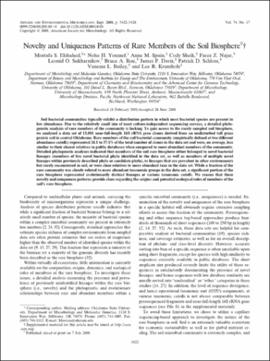| dc.contributor.author | Elshahed, Mostafa S. | |
| dc.contributor.author | Youssef, Noha H. | |
| dc.contributor.author | Spain, Anne M. | |
| dc.contributor.author | Sheik, Cody | |
| dc.contributor.author | Najar, Fares Z. | |
| dc.contributor.author | Sukharnikov, Leonid O. | |
| dc.contributor.author | Roe, Bruce A. | |
| dc.contributor.author | Davis, James P. | |
| dc.contributor.author | Schloss, Patrick D. | |
| dc.contributor.author | Bailey, Vanessa L. | |
| dc.contributor.author | Krumholz, Lee R. | |
| dc.date.accessioned | 2018-08-29T14:24:28Z | |
| dc.date.available | 2018-08-29T14:24:28Z | |
| dc.date.issued | 2008-09 | |
| dc.identifier | oksd_elshahed_noveltyanduniqu_2008 | |
| dc.identifier.citation | Elshahed, M. S., Youssef, N. H., Spain, A. M., Sheik, C., Najar, F. Z., Sukharnikov, L. O., ... Krumholz, L. R. (2008). Novelty and uniqueness patterns of rare members of the soil biosphere. Applied and Environmental Microbiology, 74(17), 5422-5428. https://doi.org/10.1128/AEM.00410-08 | |
| dc.identifier.uri | https://hdl.handle.net/11244/301599 | |
| dc.description.abstract | Soil bacterial communities typically exhibit a distribution pattern in which most bacterial species are present in low abundance. Due to the relatively small size of most culture-independent sequencing surveys, a detailed phylogenetic analysis of rare members of the community is lacking. To gain access to the rarely sampled soil biosphere, we analyzed a data set of 13,001 near-full-length 16S rRNA gene clones derived from an undisturbed tall grass prairie soil in central Oklahoma. Rare members of the soil bacterial community (empirically defined at two different abundance cutoffs) represented 18.1 to 37.1% of the total number of clones in the data set and were, on average, less similar to their closest relatives in public databases when compared to more abundant members of the community. Detailed phylogenetic analyses indicated that members of the soil rare biosphere either belonged to novel bacterial lineages (members of five novel bacterial phyla identified in the data set, as well as members of multiple novel lineages within previously described phyla or candidate phyla), to lineages that are prevalent in other environments but rarely encountered in soil, or were close relatives to more abundant taxa in the data set. While a fraction of the rare community was closely related to more abundant taxonomic groups in the data set, a significant portion of the rare biosphere represented evolutionarily distinct lineages at various taxonomic cutoffs. We reason that these novelty and uniqueness patterns provide clues regarding the origins and potential ecological roles of members of the soil's rare biosphere. | |
| dc.format | application/pdf | |
| dc.language | en_US | |
| dc.publisher | American Society for Microbiology | |
| dc.rights | This material has been previously published. In the Oklahoma State University Library's institutional repository this version is made available through the open access principles and the terms of agreement/consent between the author(s) and the publisher. The permission policy on the use, reproduction or distribution of the material falls under fair use for educational, scholarship, and research purposes. Contact Digital Resources and Discovery Services at lib-dls@okstate.edu or 405-744-9161 for further information. | |
| dc.title | Novelty and uniqueness patterns of rare members of the soil biosphere | |
| osu.filename | oksd_elshahed_noveltyanduniqu_2008.pdf | |
| dc.description.peerreview | Peer reviewed | |
| dc.identifier.doi | 10.1128/AEM.00410-08 | |
| dc.description.department | Microbiology and Molecular Genetics | |
| dc.type.genre | Article | |
| dc.type.material | Text | |
| dc.subject.keywords | bacteria | |
| dc.subject.keywords | biodiversity | |
| dc.subject.keywords | gene library | |
| dc.subject.keywords | genetic variation | |
| dc.subject.keywords | molecular sequence data | |
| dc.subject.keywords | oklahoma | |
| dc.subject.keywords | phylogeny | |
| dc.subject.keywords | polymerase chain reaction | |
| dc.subject.keywords | soil microbiology | |
